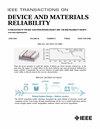NBTI效应的12nm p - finet等效电路模型
IF 2.3
3区 工程技术
Q2 ENGINEERING, ELECTRICAL & ELECTRONIC
IEEE Transactions on Device and Materials Reliability
Pub Date : 2025-02-20
DOI:10.1109/TDMR.2025.3543863
引用次数: 0
摘要
提出了一种基于12nm CMOS PDK的P-FinFET和EDA软件的电子元件和运算单元的负偏置温度不稳定性等效电路模型。P-FinFET电路模型由电压源、控制源、加法器和乘法器以及其他算术单元等电子元件组成。该模型设置了五个可调的输入参数,包括应力时间、栅极宽度、栅极长度、工艺角(慢/快/典型)和温度。等效电路模型还考虑了影响NBTI的晶体管偏置条件,如栅极源电压、漏极源电压和漏极栅极电压。仿真结果表明,P-FinFET等效电路模型的退化曲线与已有文献的实验数据一致。本文章由计算机程序翻译,如有差异,请以英文原文为准。
An Equivalent Circuit Model of 12 nm P-FinFET for NBTI Effect
A negative bias temperature instability (NBTI) equivalent circuit model based on P-FinFET of a 12nm CMOS PDK and electrical components and arithmetic units of EDA software is presented. The P-FinFET circuit model consists of electrical components such as voltage sources, controlled sources, adders and multipliers, and other arithmetic units. The model is set up with five tunable input parameters, including stress time, gate width, gate length, process corner (slow/ fast/ typical), and temperature. The equivalent circuit model also takes into account bias conditions of transistor, such as gate-source voltage, drain source voltage, and drain gate voltage, which will affect NBTI. Simulation result shows that the degradation curves of the equivalent circuit model for P-FinFET are in concordance with experimental data presented in previously published literatures.
求助全文
通过发布文献求助,成功后即可免费获取论文全文。
去求助
来源期刊

IEEE Transactions on Device and Materials Reliability
工程技术-工程:电子与电气
CiteScore
4.80
自引率
5.00%
发文量
71
审稿时长
6-12 weeks
期刊介绍:
The scope of the publication includes, but is not limited to Reliability of: Devices, Materials, Processes, Interfaces, Integrated Microsystems (including MEMS & Sensors), Transistors, Technology (CMOS, BiCMOS, etc.), Integrated Circuits (IC, SSI, MSI, LSI, ULSI, ELSI, etc.), Thin Film Transistor Applications. The measurement and understanding of the reliability of such entities at each phase, from the concept stage through research and development and into manufacturing scale-up, provides the overall database on the reliability of the devices, materials, processes, package and other necessities for the successful introduction of a product to market. This reliability database is the foundation for a quality product, which meets customer expectation. A product so developed has high reliability. High quality will be achieved because product weaknesses will have been found (root cause analysis) and designed out of the final product. This process of ever increasing reliability and quality will result in a superior product. In the end, reliability and quality are not one thing; but in a sense everything, which can be or has to be done to guarantee that the product successfully performs in the field under customer conditions. Our goal is to capture these advances. An additional objective is to focus cross fertilized communication in the state of the art of reliability of electronic materials and devices and provide fundamental understanding of basic phenomena that affect reliability. In addition, the publication is a forum for interdisciplinary studies on reliability. An overall goal is to provide leading edge/state of the art information, which is critically relevant to the creation of reliable products.
 求助内容:
求助内容: 应助结果提醒方式:
应助结果提醒方式:


